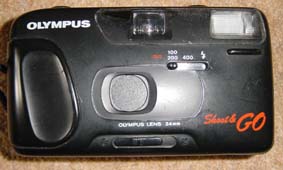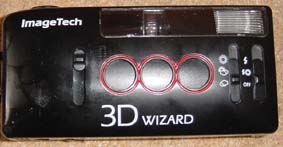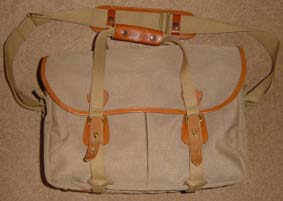|
Photography
Photography in the Antarctic is a challenge to say the least.
The first challenge is the cold. It makes the lubricants in the camera lenses &
body stiffen. This drains the battery of an automatic camera, and just makes the
camera less responsive. Manipulating a camera with mittens on is awkward, so you
take them off and your fingers go numb very quickly - cameras are solid objects
and suck the heat from your fingers. If you breathe on the view finder, it
freezes over and you can't see through it, so you learn to hold your breath
until the view finder is against your eye. Some cameras are made of metal, which
will stick to your fingers, cheek, nose on contact. Camera film is made from a
sheet of plastic with a layer of chemicals (called the emulsion) on it. When
film gets cold, say -40C and lower, the emulsion becomes brittle. Consequently,
if you wind on the film to vigorously the emulsion will crack, leaving
vertical white lines in your pictures. If you get too carried away, the film
itself will break. The cold also saps the energy from your batteries. I often
carried one battery inside my coat to keep it warm & kept swapping it with the
one in the camera.
Once you have conquered the cold, the next problem is the
light. When everything is covered in snow the sun is reflected all about and the
world is very bright. Metering systems on cameras are calibrated for normal
light conditions so they will tend to under expose the picture. Consequently,
you have to judge the amount of light on your subject and slightly over expose
the shot in order to get it right. AS you will see from the pictures on this
site, I didn't get it right all the time - quite a few are too dark.
Once you have overcome the Cold and the Light you must face
the realities of the snow. Snow gets in everywhere, so when you change a lens or
replace a film in the camera, you must take great care to prevent the snow
getting into the camera. It might not do much damage initially, but it'll turn
to water when it warms up and you don't want water in a camera.
Much like clothing, everyone had their own ideas when it came
to choice of cameras & equipment. I was advised to take a manual SLR
camera and told that automatic cameras just weren't viable. I chose to heed &
ignore this advice at the same time. My manual SLR served me very well, but I
also got some great shots with my compact zoom camera in -35C and my top of the
range autofocus SLR in all sorts of conditions. I even changed lenses & replaced
film in drifting snow conditions. When you see something worth taking a picture
of, you do what it takes to get the shot. The consequence of this was that bits
fell off my Praktica, and my expensive 28-105 computer controlled zoom lens
makes a curious crunching noise when the power zoom is used. Here is a
comprehensive record of the cameras that I used on my trip.
| |
 This
is my trusty Praktica MTL50. My parents gave me this for one teenage
birthday (or maybe Christmas), so I already had it when I got the job. It
has a 42mm screw fit mount (not very convenient with cold fingers or big
mittens), and
you can see the bit of masking tape covering the hole where the self timer
lever used to be. That fell off one cold day. Otherwise, it was a great
camera. The bundle of wires is a modification that I made to put the
battery inside my coat (this powered the light meter). I would walk about
with the end of the wire hanging out of my coat and when I wanted to take
a photo, I just plugged it into the camera and snapped away. This camera
is completely manual, which gave me control of the wind-on. On very cold
days I could wind on very slowly & gently. I never snapped a film in any
of my cameras, but I did crack the odd emulsion. With this camera I had
the following lenses: Prinzflex 80-200mm f4.5 - 5.6; Vivitar 24mm f2.8;
Pentacon 50mm f1.8, Helios 2x teleconverter. Later on I had a Vivitar
28-210mm f3.5-5.6 lens sent down to me but I didn't actually use it. I
lent this lens to a colleague and he brought it back to me from a trip to
the coast covered in sea water - a penguin jumped out of the sea and
practically landed in his lap! The cable release was essential for Aurora
photographs, for which I'd leave the shutter open for anything from 30
seconds to five minutes (I never did get the hang of it, but I think
exposures of 2-5 minutes worked best). This
is my trusty Praktica MTL50. My parents gave me this for one teenage
birthday (or maybe Christmas), so I already had it when I got the job. It
has a 42mm screw fit mount (not very convenient with cold fingers or big
mittens), and
you can see the bit of masking tape covering the hole where the self timer
lever used to be. That fell off one cold day. Otherwise, it was a great
camera. The bundle of wires is a modification that I made to put the
battery inside my coat (this powered the light meter). I would walk about
with the end of the wire hanging out of my coat and when I wanted to take
a photo, I just plugged it into the camera and snapped away. This camera
is completely manual, which gave me control of the wind-on. On very cold
days I could wind on very slowly & gently. I never snapped a film in any
of my cameras, but I did crack the odd emulsion. With this camera I had
the following lenses: Prinzflex 80-200mm f4.5 - 5.6; Vivitar 24mm f2.8;
Pentacon 50mm f1.8, Helios 2x teleconverter. Later on I had a Vivitar
28-210mm f3.5-5.6 lens sent down to me but I didn't actually use it. I
lent this lens to a colleague and he brought it back to me from a trip to
the coast covered in sea water - a penguin jumped out of the sea and
practically landed in his lap! The cable release was essential for Aurora
photographs, for which I'd leave the shutter open for anything from 30
seconds to five minutes (I never did get the hang of it, but I think
exposures of 2-5 minutes worked best). |
|
| |
 This
is my Canon Sureshot zoom compact camera. We were told that this sort of
camera would not be much use in the low temperatures so I duly ignored the
warnings & bought this on the ship on the way South. This is how one can
achieve surprising results ( ie ignore the advice & do what you want). I
used this camera in -36C with no trouble. I was photographing a football
match at the time. The only precaution I took was to keep the camera in a
pouch around my neck (inside my coat) and whip it out to take a photo &
promptly return it to the warm. I was surprised that the film didn't snap
& the zoom still zoomed, but that's what you get for trying things.
Eventually, the camera got a bit temperamental but by then I had taken
some good pictures. It still works, you just have to help the lens out
when you switch it on. More damage was caused by drowning it in white wine
during one party & then dousing it in insect repellent on holiday after my
return to warmer climes. This
is my Canon Sureshot zoom compact camera. We were told that this sort of
camera would not be much use in the low temperatures so I duly ignored the
warnings & bought this on the ship on the way South. This is how one can
achieve surprising results ( ie ignore the advice & do what you want). I
used this camera in -36C with no trouble. I was photographing a football
match at the time. The only precaution I took was to keep the camera in a
pouch around my neck (inside my coat) and whip it out to take a photo &
promptly return it to the warm. I was surprised that the film didn't snap
& the zoom still zoomed, but that's what you get for trying things.
Eventually, the camera got a bit temperamental but by then I had taken
some good pictures. It still works, you just have to help the lens out
when you switch it on. More damage was caused by drowning it in white wine
during one party & then dousing it in insect repellent on holiday after my
return to warmer climes.
This is the pouch I used. It's just the cover from a pair of Bolle Goggles
with a bit of string sewn on, but it did the trick. |
|
| |
 This is my tripod.
I bought it off a chap at HQ before I went South, so it had already
survived one winter at Halley. He'd replaced the head while he was down
there so I figured it was up to it. I still use it today, though it is
really rather dodgy. I had to replace the head myself. I think the plastic
bits get too brittle in the cold (I used this for Auroras, so it's be -40C
or less) and they snapped & cracked. Fortunately, I was able to repair the
tripod (or, rather, get my friend to repair it) using bits from someone
else's broken tripod. This is my tripod.
I bought it off a chap at HQ before I went South, so it had already
survived one winter at Halley. He'd replaced the head while he was down
there so I figured it was up to it. I still use it today, though it is
really rather dodgy. I had to replace the head myself. I think the plastic
bits get too brittle in the cold (I used this for Auroras, so it's be -40C
or less) and they snapped & cracked. Fortunately, I was able to repair the
tripod (or, rather, get my friend to repair it) using bits from someone
else's broken tripod. |
|
| |
 This is my cobra
camera bag. It was tough & hard wearing but only really served as a means
of keeping all my kit together on base. I didn't carry it around on field
trips as I already had enough clatch strapped & clipped to me. This is my cobra
camera bag. It was tough & hard wearing but only really served as a means
of keeping all my kit together on base. I didn't carry it around on field
trips as I already had enough clatch strapped & clipped to me. |
|
| |
 These are Camera Care
Systems (CCS) pouches. They are very good indeed for carrying cameras &
lenses about in the wilds. I'd put two of them on my belt, holding camera
& one lens. They were well padded & gave easy access to the contents, even
with big mits on. These are Camera Care
Systems (CCS) pouches. They are very good indeed for carrying cameras &
lenses about in the wilds. I'd put two of them on my belt, holding camera
& one lens. They were well padded & gave easy access to the contents, even
with big mits on.
I pulled an old worn out climbing harness out of the bin, chopped off the
leg straps & turned it into a very good camera belt, to hold the CCS
pouches. The belt that came with the pouches, also made by CCS, was
absolutely rubbish - the catch kept popping open, sending my expensive
cameras plunging to the ground. |
|
| |
 I bought this
before I went because the £10 snapping camera that I used throughout my 6
years at Polytechnic fell to bits in the summer before I left. The flash
on this wasn't really up to much so I didn't use it much at all. I bought this
before I went because the £10 snapping camera that I used throughout my 6
years at Polytechnic fell to bits in the summer before I left. The flash
on this wasn't really up to much so I didn't use it much at all. |
|
| |
 In my second
summer an interesting parcel arrived from the UK. I had discovered the
joys of the Jessops catalogue & ordered myself some top of the range kit.
This took the form of a Minolta Dynax 9xi camera; Zoom xi 28-105mm
f3.5 - 4.5; Zoom xi 100-300mm f4.5 -5.6; Teleplus 2x teleconverter &
Minolta 5400xi Flash. This gear really was about as posh as it gets & I
decided to buy it because the warnings I had received against buying it
seemed to be unfounded (after my experience with the Canon zoom camera). I
used this for everything apart from Aurora photos (The Praktica was best
for these as it really would have been too cold for the Minolta). I'd say
temperatures down to -35C (Field trips, trips to the penguins, around
base, inside the base, in the tunnels etc etc). The only problem I had
with it was the 28-100 zoom lens. Being top of the range gear, it had a
power zoom and after I fell over on it on one field trip the power zoom
sounded more like a power crusher, so I am left with a manual zoom on that
lens, what a bind! The batteries would drain in the cold, so I would turn
of the power zoom & keep two spares inside my coat. Once the batteries are
warmed up again they spring back into life, so you just keep rotating
them. Most of my best photos were taken with this kit. In my second
summer an interesting parcel arrived from the UK. I had discovered the
joys of the Jessops catalogue & ordered myself some top of the range kit.
This took the form of a Minolta Dynax 9xi camera; Zoom xi 28-105mm
f3.5 - 4.5; Zoom xi 100-300mm f4.5 -5.6; Teleplus 2x teleconverter &
Minolta 5400xi Flash. This gear really was about as posh as it gets & I
decided to buy it because the warnings I had received against buying it
seemed to be unfounded (after my experience with the Canon zoom camera). I
used this for everything apart from Aurora photos (The Praktica was best
for these as it really would have been too cold for the Minolta). I'd say
temperatures down to -35C (Field trips, trips to the penguins, around
base, inside the base, in the tunnels etc etc). The only problem I had
with it was the 28-100 zoom lens. Being top of the range gear, it had a
power zoom and after I fell over on it on one field trip the power zoom
sounded more like a power crusher, so I am left with a manual zoom on that
lens, what a bind! The batteries would drain in the cold, so I would turn
of the power zoom & keep two spares inside my coat. Once the batteries are
warmed up again they spring back into life, so you just keep rotating
them. Most of my best photos were taken with this kit. |
|
| |
 Here's an
oddity. It's a 3d camera that I had sent down with the Minolta in December
1994. I took a few rolls with this and got some interesting results.
Unfortunately, I didn't notice a hair in one of the shutter irises so
quite a few pictures were ruined. I still have a roll to develop, but I
haven't had it done because I know the hair was still there. I didn't see
any of the results until my last summer as they had to go back to the UK
for specialised processing. Here's an
oddity. It's a 3d camera that I had sent down with the Minolta in December
1994. I took a few rolls with this and got some interesting results.
Unfortunately, I didn't notice a hair in one of the shutter irises so
quite a few pictures were ruined. I still have a roll to develop, but I
haven't had it done because I know the hair was still there. I didn't see
any of the results until my last summer as they had to go back to the UK
for specialised processing. |
|
| |
 To hold all
this new kit I also got this Billingham bag. It was too big to take
anywhere really, so it served as a very posh place to keep it all together
on base. It's amazing what you buy when you're sitting in an Antarctic
base in the middle of winter... To hold all
this new kit I also got this Billingham bag. It was too big to take
anywhere really, so it served as a very posh place to keep it all together
on base. It's amazing what you buy when you're sitting in an Antarctic
base in the middle of winter... |
|
|
